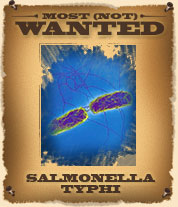
Photo: © Dr. Volker Brinkmann,
MPI for Infection Biology
Name
Salmonella typhi
Also known as
Typhoid fever, enteric fever
Description
- rod-shaped bacterium with few distinguishing marks
(Not) Wanted for
causing typhoid fever, which each year kills about 600,000 people and sickens about 21.5 million.
Modus operandi
- sneaks unnoticed into its victim through contaminated water or food
- causes high fever, stomach pains, diarrhoea, headache, and (sometimes) rose-coloured spots
- if no action taken against infection, will linger for weeks or even months and kill about one in every five persons affected
- in about 5% of survivors, may remain hidden after symptoms disappear, creating carriers who help spread the disease unknowingly
Preferred hideouts
- human bloodstream and intestines
Preferred means of travel
- at first, human faeces, then primarily water
- may also use food, dirty hands, and insects
Associates
- one of the Salmonella crime family
- close relatives known to be responsible for paratyphoid and outbreaks of many food-borne illness (Salmonella food poisoning)
Area of operation
- prefers areas lacking good water-treatment and sewage-disposal systems
Learn about other pathogens on the Most (Not) Wanted list...
Escherichia coli
Campylobacter jejuni
Giardia lamblia
Vibrio cholerae


